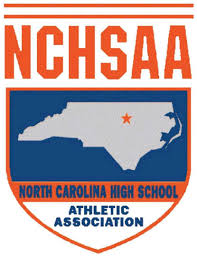
Photo contributed by NCHSAA
Spring sports are in the air, and so is the change coming to high school sports. In the next few years, we will see some of the changes coming to high school sports as they are significantly changed in the years to come. In the fall, our school will have a new conference rival, the introduction of Name, Image, and Likeness deals (NIL), and shift the responsibility of the NCHSAA as it currently stands. In the future, we will see an expanded classification system with conference realignment in 2025-2026.
One of the most impactful changes will be the addition of a new conference opponent to our sports teams’ schedules as Ballantyne Ridge High School opens its doors in the fall. The athletic teams will be known as the Ballantyne Ridge Wolves, wearing orange, gray, and Carolina blue. Ballantyne joined the conference two years after Palisades, another relief high school, opened its doors. The Wolves will be the 7th team in the conference and intend to offer all sponsored CMS sports with both JV and Varsity teams. The school’s athletics will be led by newly hired athletic director Jeff Smith and will be hiring coaches in the coming months.
Another change is the adoption of the NIL policy for private school athletes. The main governing body of independent high schools, the NCISAA, approved NIL deals for private schools athletes in February. Under the rules established, schools can not use NIL to recruit students, and students are prohibited from doing deals that promote certain activities such as alcohol, gambling, and cannabis. The approved proposal was similar to that of the public school body, the NCHSAA, who attempted to introduce NIL to public schools last year but was shut down by legislators. The recent move by the NCISAA has raised fears that private schools will be able to lure public school students looking to receive NIL money, creating an increasing gap between public and private schools.
NIL was not the only thing impacted by the legislature, as politicians in Raleigh passed a bill that dramatically reshaped the authority of the NCHSAA. The bill handicaps the ability of the Association to raise money and provide scholarships and would give much authority to the Superintendent of Public Instruction, Catherine Truitt. The Association would have to work more closely with the Superintendent’s Office moving forward, with the full impacts not being for a couple of years. The most impactful implication is a potentially degraded championship experience, caused by the loss of corporate sponsorships. This could lead to games being moved from large venues to small school facilities which would create ticket crunches similar to last year’s regional game between Myers Park and North Mecklenburg.
While those impacts are still speculative, one of the most important changes is the expansion of the school classification system in North Carolina, moving from 1A-4A all the way to 8A, creating 4 additional classifications. The new classification would coincide with conference realignment in the 2025-2026 school year, and would provide room for growth for the NCHSAA as more schools are added. Hopefully this change will create a more even playing field between schools because schools would be placed according to average daily membership numbers, which correlates to school size. Some do fear that the new classification would disadvantage schools by taking away school performance as a factor in aligning the school, as was previously the case in the 1A-4A system.
Ultimately, high school sports will face many changes and challenges in the years to come. Regardless of these changes, one thing that will never change is how high school sports are such a significant part of the high school experience. Our lives are forever touched by the experience of high school sports, whether we are athletes or spectators cheering on our teams.
